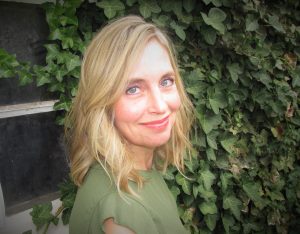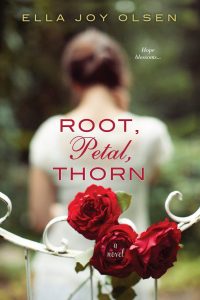Q&A with Ella Joy Olsen
Ella Joy Olsen is the debut author of ROOT, PETAL, THORN (Kensington, 2016) and two-time contributor to WWWB. Do not send your manuscript anywhere until you’ve read this piece: “Look Away. You Don’t Want To See This.” As I read it, I cringed, hung my head, and then thanked her. I might have related just a wee bit. Here she talks about insecurity in writing.
Ella was born, raised, and currently resides in Salt Lake City, Utah with her three children, two dogs, and husband. She spent nearly a decade on the Board of Directors for the Salt Lake City Public Library System (and four decades browsing the stacks). Though she’s crazy about words, Ella is also practical, so she graduated from the University of Utah with a degree in Finance. Years later, Ella eagerly gave up her corner cubicle and started writing fiction. She has also lived in Seattle, Washington & Savannah, Georgia.
She is a member of Tall Poppy Writers, Women’s Fiction Writers Association, and what she believes to be the best book club ever: Salt Lake Bibliophiles. She is also one of September’s WWWB sponsors so we love her extra, extra much!
Let’s start at the beginning.
 Where did you grow up? How did it impact the woman and writer you’ve become?
Where did you grow up? How did it impact the woman and writer you’ve become?
I grew up in Salt Lake City about twenty minutes from where I live now. I was an only child until I was ten when my family adopted my little brother from Korea. Followed closely on the heels of the adoption, my mom had baby (another brother), and three years after that (when I was fifteen) I got a sister.
I was still practically a kid, myself, when I got married (age nineteen) and my husband and I moved to Seattle for work/school. After years in Seattle and a brief stint in Savannah, I realized I wanted to come home. Once reunited, I fell in love with my hometown…and as a result, I wrote a couple of books based here.
What were you like as a kid? A teen?
As a kid, I read constantly. I would read while walking to school, I read ghost stories and romances to my friends at sleepovers, and on school nights when I was supposed to be sleeping I read by the light under the door. I’m proud to say I won most of the reading contests in elementary.
As a teen, I was a little rebellious and made stupid decisions, just like all teens. It’s the reason having three teens of my own is such a nail-biter. I just want my children to make it to the other side without permanent damage.
Favorite band?
I tire of music rather quickly, so I tend to hop around. That means I’m not one of those nostalgic music listeners of ‘80s or ‘90s classics. I take that back, I can’t seem to get sick of the soundtrack from Hamilton. My kids wish I would, though, so I’d stop singing random phrases at them while they’re talking to me. My favorite line: “I am not throwing away my shot.” If you’re familiar with the musical, or with lazy teens, you’ll realize this is super applicable in many circumstances.
Favorite food?
Anything Mediterranean. Throw a few tomatoes, a little feta, a healthy dose of garlic, and Greek olives on dog food and I’d eat it.
Hidden talent?
I love to dance. And I’m awful. But sign me up for a Zumba class or take me to a concert and I’m bouncing. I’ve taken pole dancing (huge fail), and I’ve just signed up for a flamenco class with props – castanets and scarves. Where will I use these skills? Does it matter?
ROOT, PETAL, THORN is not autobiographical but it does borrow from your personal experience. How so?
It borrows from my life in so many ways that I’m a little worried readers will think everything in Root, Petal, Thorn is true. However, the characters are entirely fictional (their lives are much more interesting than mine). That said…the story does take place in my neighborhood, in a home very similar to mine (see following questions for even more detail). The house is old, a fixer-upper, so to speak. As my husband and I “fixed” it, we would always speculate about who made the changes we were busy removing or painting over. And then there were the odd things we’d find tucked into forgotten corners – old newspapers, handprints in concrete, a stray article of clothing. These types of discoveries, called Easter eggs, are what I gave to my modern day character, Ivy, allowing her to discover the women who lived in her home before she came along.
ROOT, PETAL, THORN has several narrators. They are all very different people with very different struggles. (The interviewer’s personal favorites were the crotchety Greek mother and the older (feminist?) Mormon sister.) On top of that, they live at different times in history. Do you find writing multiple points-of-view challenging or freeing? How so? Same question for multiple eras?
When I started writing this book I had no preconceived notion about what it would become. I had decided to teach myself to write and thought I’d start by describing something I knew: my house. I’d often wondered about the families who’d lived in my hundred-year-old home, so I started imagining.
After a (long) time, I had four first person narratives. Basically, I’d written four historical fiction novels. Emmeline’s story, alone, was almost 100,000 words. Hers is currently one of five stories in Root, Petal, Thorn and is about 20,000 words…and that’s called killing your darlings.
So, it wasn’t difficult while I was writing. I wasn’t thinking about the final product and I didn’t know what I was doing. The braiding and the editing…now that was tough. Thank goodness for Scrivner. I could have never done it without this tool!
A certain rose bush connects all the stories and women who lived in the house. The protagonist, Ivy Baygren, digs through library records and follows coincidental clues to discover who the women who shared her home before her. Are you a gardener or history buff? If you weren’t before, are you now? What went into your research?
I think most authors share their passions in the pages of any book they write. So, yes, I am a gardener and I have a rose garden. In that garden, I planted a start from a rose taken from my great-grandmother’s yard, which apparently came from her great-grandmother across the plains during one of the Mormon migrations to Utah. So now you know how the Emmeline Rose relates to my own life.
I am also a history buff! I love old photos, especially of places that are familiar to me. I like to look for changes in the surroundings and I speculate about what was happening just outside the frame when the photo was taken. So Root, Petal, Thorn is an extension of the imagining I always do. It’s my in-my-head version of historical fiction.
Did anything about how ROOT, PETAL, THORN turned out surprise you?
Oh, almost everything. What was really surprising was how much each story morphed and changed from the original rough draft. I had a lot of learning to do.
ROOT, PETAL, THORN is a gorgeous title with an equally gorgeous cover. What was that decision process like? Did you have a say in either?
Root, Petal, Thorn has been named many things. I originally pitched it as The House of Brick and Thorn, which I still like. My agent and I worked together to come up with RPT, and it changed several times at the publishing house…but fortunately they came back to it.
Regarding the cover, my editor asked me to present her with several images I liked. So I did and a month later they handed me a cover that looked nothing like anything I’d chosen. I was a little distraught, but the cover art has grown on me and now I ADORE it! Although I know my book is solidly women’s fiction, I tend to read quite a bit of literary fiction, so I wanted something I deemed more literary – a little more obscure, a little less photo image. Turns out, my publisher knew best.
You have another book on the horizon, WHERE THE SWEET BIRD SINGS. What was it like to write a book under contract?
During the query process for Root, Petal, Thorn I had major surgery and I couldn’t move around for about six weeks…which happened to fall during the month of November. So I thought I’d try NANOWRIMO. I nearly finished a book which I love (but haven’t shopped) during those weeks, so when I signed a contract for a second book, and they gave me a year to write it, I was pretty sure I could do it.
That said, while writing Where the Sweet Bird Sings I didn’t indulgently follow any old whim regarding storyline and research. I set a daily word goal and put my butt in the chair. I finished the first draft in three months, and it was good I had some extra time to edit, because it sure needed it.
Some authors’ works springs from a specific passion (e.g., motherhood, life and death decisions, ethical dilemmas). Is there a common theme between your first two books? Do you intend to explore it in a different variation in book three or are there other topics or genres that hold interest for you?
Sweet Bird (as I call it) is a linked-book to Root, Petal, Thorn – meaning the two novels share one common character. It could be read as a stand-alone or the two books could be read in either order. And it is nothing like RPT. It is a contemporary women’s fiction with only one narrator. If I were to look for a common theme between the two books it would be: searching for secrets from the past. The main character in Sweet Bird does a bunch of ancestry and DNA research. Here is the official teaser for Where the Sweet Bird Sings:
Though she has a loving husband, Emma Hazelton is adrift, struggling to rebuild her life after a tragedy. But one day, a simple question and an old black-and-white photograph prompt Emma to untangle the branches of her family tree, where she discovers a legacy of secrets. What connects us to another? Is it shared history? Is it ancestry? Or is it love?
Regarding book number three: I have a few ideas churning…but nothing solid, and definitely nothing that I could assign a theme.
Do you plot your books or write them from the seat of your pants? If you are a plotter, to what extent do you know what is going to happen?
Definitely a pantser. Before I write, I have a general idea of where I “want” to go and maybe a scene or two in mind…but the rest happens as it happens. The cohesion occurs when I edit. I love the editing process. At the beginning it seems so daunting but then the pieces start to fit. It’s like putting together the world’s best jigsaw puzzle.
You are a mother of children and pets, a wife, a writer, and undoubtedly more. How do you balance all of your roles? Do you have a set writing schedule? What does it look like?
I do my very best writing immediately when I wake up. Coffee by my side, I put in two super-poppin’ hours. Unfortunately, when school is in session, the kids get up by 6:45 and I have to stop to make them breakfast. We all sit down for scrambled eggs so they aren’t starving by lunch time. Train of thought derailed, I try to get back on board once they leave for school.
What is the most meaningful or helpful advice you’ve been given in your writing career? Anything you’d like to add to that for writers still climbing the publishing mountain?
I think the most meaningful thing for me was finding my tribe. For most of the years I was writing and querying I felt like I was alone. I read the Query Tracker blog like it was the Bible…but it took some time to find interactive groups that were a fit: Women Writers, Women’s Books, Women’s Fiction Writers Association, Tall Poppy Writers, and several others. Within these groups I’ve found cheerleaders, mentors, and friends.
Advice for those still climbing the publishing mountain: Don’t turn back. And when in doubt, follow a friend who’s right in front of you (meaning they’ve just gone through the same thing). They are super generous with timely knowledge and support. Take their hand and let them pull you through the brush…but don’t forget to reach back and grab the buddy behind you.
Thank you, Ella, so much dropping in. You are a beloved member of the WWWB family! We will continue to support and root for you forever more.
Thank you, Peggy! I love your interviews and I’m so happy to be here!
Praise for ROOT, PETAL, THORN –
 “Root, Petal, Thorn is a fascinating novel that centers around the history of a house and those who lived there throughout different time periods: the young woman in the early 1900’s who is torn between her heart and her beliefs, the mother who will stoop to low levels to prevent her son from marching off to World War II, and more. Ella Joy Olsen mixes history and genealogy into a believable novel.” – RT Book Reviews – 4.5 Stars Top Pick
“Root, Petal, Thorn is a fascinating novel that centers around the history of a house and those who lived there throughout different time periods: the young woman in the early 1900’s who is torn between her heart and her beliefs, the mother who will stoop to low levels to prevent her son from marching off to World War II, and more. Ella Joy Olsen mixes history and genealogy into a believable novel.” – RT Book Reviews – 4.5 Stars Top Pick
“Exploring the residents of one house gives Olsen a way to explore the layers of lived experience that eventually turn into what we know as history. [It is] provocative in the way it explodes and expands the category of historical fiction.” – Ellen Fagg Weist – The Salt Lake Tribune
“Five women. Five complicated lives. One house where they all live over a period of one hundred years. In this story, the walls talk.Wonderful, compelling saga!” – Cathy Lamb, author of The Language of Sisters
“Within this captivating debut, we recognize ourselves, our mothers, our sisters, and our daughters in these flawed yet endearing characters. In reading, we are left with a deeper appreciate for our own imperfect lives.” – Sandra Kring, bestselling author of The Book of Bright Ideas and Carry Me Home
“Olsen does a remarkable job re-creating each historical era, from the days before WWI to the present time. Each time period is as vivid and true as her captivating characters. Olsen is an emerging voice to watch for in historical and contemporary women’s fiction.” – Aimie K. Runyan, author Promised to the Crown
ROOT, PETAL, THORN is Available
Amazon Barnes & Noble Indiebound
Other ways to bond with Ella –
Interviewed by –

MM Finck
MM Finck is a writer, essayist, and book reviewer. She oversees WWWB’s Interviews and Agents’ Corner segments. Her women’s fiction and is represented by Katie Shea Boutillier of the Donald Maass Literary Agency. She is a member of the Women’s Fiction Writers Association and the contest chair for the Women’s Fiction Writers Association 2016 Rising Star writing contest for unpublished authors.
Her work has appeared in national and regional publications, including skirt! magazine. When she isn’t editing her novel, #LOVEIN140, you can find her belting out Broadway tunes (off key and with the wrong words), cheering herself hoarse over a soccer match (USWNT!), learning to play piano (truly pitifully), building or fixing household things, and trying to squeeze more than twenty-four hours out of every day. She is active on Facebook, Twitter, Goodreads, Li.st (@MMFinck), and Litsy (@MMF). http://www.mmfinck.com
Category: Interviews






























